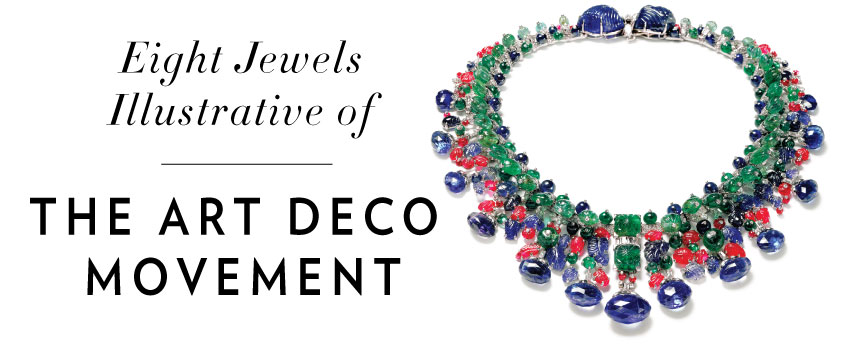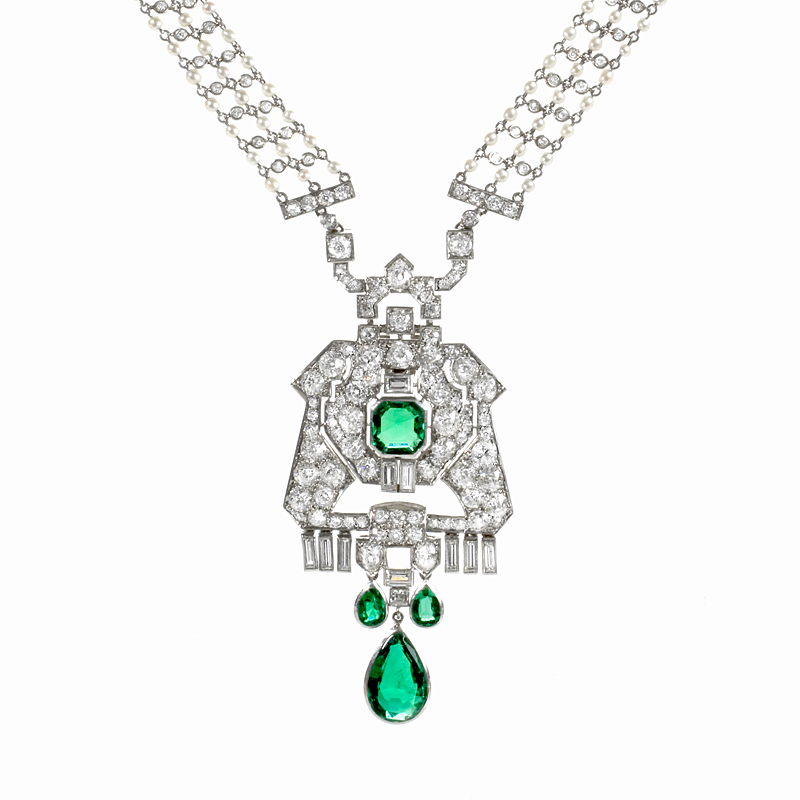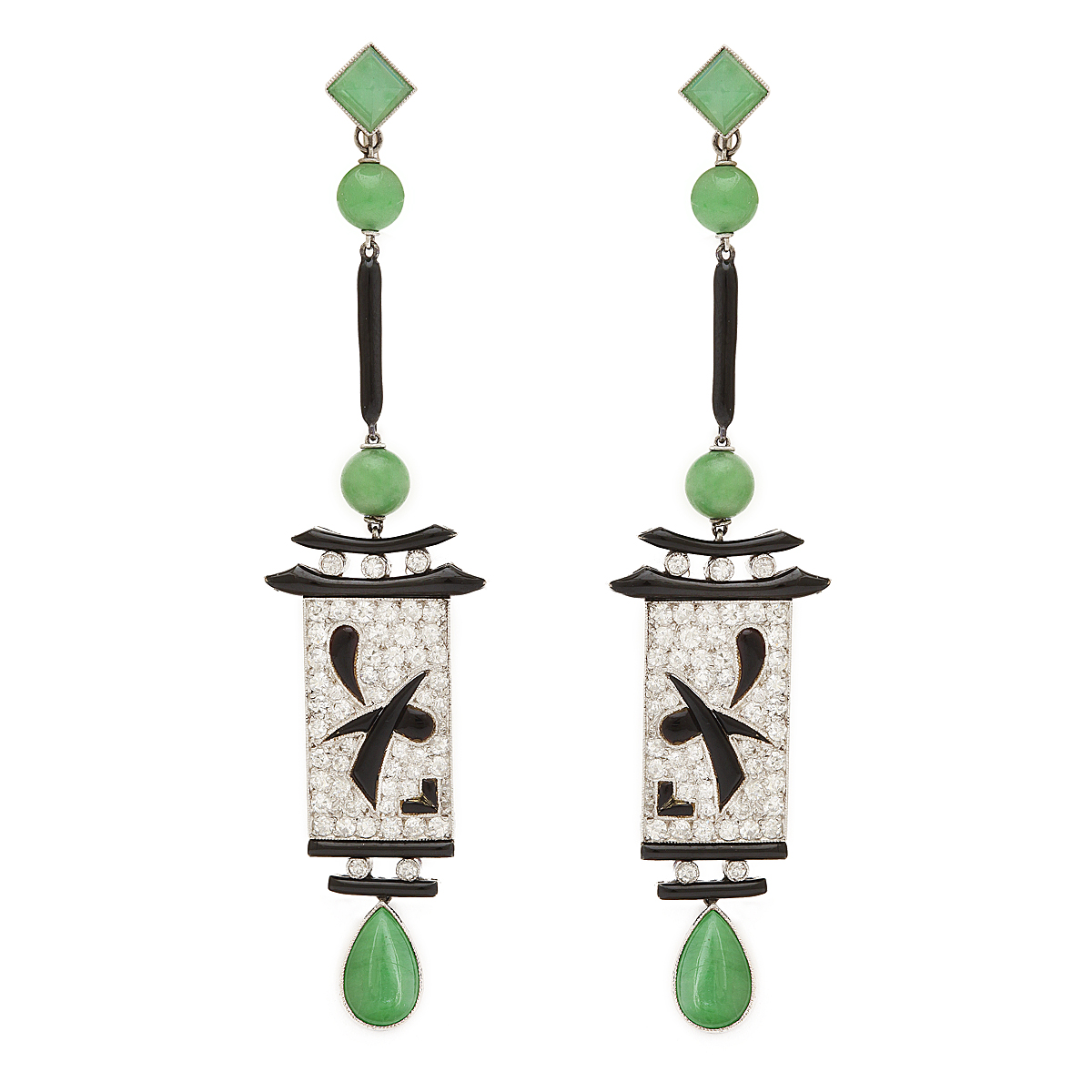The Styles and Silhouettes of Art Deco continues to influence jewelry today.

Opening Image (Daisey Fellowes Tutti Fruitti Necklace, 1936 (Photo courtesy of N.Welsh Cartier Collection ©Cartier
After writing about the Cooper Hewitt Exhibit, The Jazz Age: America Style In The 1920s, I thought it only befitting to follow it up with a story of the jewels most characteristic of the Art Deco movement.
The great jewelers of Paris had first rebelled in the late 19th century against the later years of the Victorian era’s industrial revolution and assembly line feeling. The result came to be called Art Nouveau, an explosive mix of unconventional precious and non-precious materials, gemstones, different types of enameling, free flowing lines and naturalistic, sometimes fantastical motifs. The proponents were the great jewelers of the time, including Rene Lalique, George Fouquet, Henri Verver and Lucien Gaillard who brought imagination and art back into design. The rest of Europe and America followed. The Art Nouveau aesthetic overlapped with the swirling femininity and embellishments of the Edwardian/Belle Époque and the great works of Boucheron, Chaumet and Cartier. But after WWI, something new was needed to match the fast pace of the machine age, the speed of travel and modern times.
Although the shift from the more flowing lines of Art Nouveau and the ornamental feeling of Belle Époque began as early as 1920, it was the Exposition International des Arts Décoratifs et Industriels Modernes in Paris in 1925 that promoted the new movement by jewelers at the exhibition who produced some of the most influential styles of the day: Raymond Templier, Cartier, Van Cleef & Arpels, Jean Fouquet, Jeanne Bovin, Suzanne Belperron, Boucheron and Chaumet. While each house had its own interpretation of Art Deco jewelry, there was a unified movement toward streamlined circular or linear looks in all white or black and white: platinum, rock crystal, onyx, and mixed cuts of white diamonds. The jazz age and new concepts in fine art and architecture such as cubism and futurism with its geometric forms and angular lines all impacted the designs. As jewelers moved into the 1930s, Art Deco was further stimulated by a global mix of cultures including Asia, Africa and Egypt. This approach softened the geometric lines with stylized florals, carved cabochons and figurative motifs, which were part of the intricate compositions of each design. Vibrant rubies and sapphires as well as onyx, jade, lapis and frosted quartz contrasted against white diamonds represented the Art Deco movement until 1939. But it is a time in the history of jewelry that is the most relevant and influential for those who collect jewelry and for contemporary designers to reference as they work to shape the modernity of today.
Here Bejeweled takes a look at eight styles and/or silhouettes that helped to define the Art Deco Movement in jewelry:
CLIP BROOCHES
Jewelers such as early proponent Raymond Templier, who was heavily influenced by cubism and on contrasting of opposing arcs and semi-circles as well as Fouquet, Bovin, Chaumet , Cartier and Belperron featured clip brooches in platinum, diamonds gemstones and/or rock crstyal. They showed clips that were multi-functional and traditionally were designed or could be separated as pairs. They could be attached to the straps of a dress, worn on handbags, on turban style hats and cloches and also on shoes. We’ve recently seen a resurgence on the red carpet among celebrities and for Spring 2017 on Carolina Herrera’s runway in which she borrowed clips from the Belperron archives for the show. Due to renewed interest, they have come out of hiding again and are being featured at antique shows for consumers to purchase and wear in various ways. (read the entire article on the clip brooch here )
- 1930 Art Deco Oscar Heyman emerald and diamond clip brooch courtesy of Simon Teakle.
- A clipe brooch at A La Vieille Russie in onyx and diamonds separated into a pair
1930 Art Deco Oscar Heyman emerald and diamond clip brooch courtesy of Simon Teakle. http://simonteakle.com
SAUTOIR NECKLACES
Ultra-long sautoirs started out in all white versions and featured geometric diamond and platinum pendants at the bottom of a long diamond and platinum chain. Many of these styles also were designed with a stylized top and tassel of pearls, diamonds or colored beads at each end of a necklace that could be knotted nonchalantly and worn down the front or back of a dress. These necklaces accessorized the styles that danced the night away during the Jazz Age at speakeasies to perfection and even evoked the flapper dresses fringe hemlines. Sautoirs were popular throughout the Art Deco period and took on cross-cultural influences of China, Egypt and India with the introduction of colored gemstones such as carved jade, coral and onyx The sautoir style is one of the reigning popular necklaces that appears on the red carpet and also amongst collectors in real life.
- Maclowe Gallery’s emerald and diamond Art Deco Sautoir necklace by Cartier Paris
- F.D. Gallery’s pearl and diamond Sautoir necklace, circa 1920a
Linear Earrings
Like the sautoir, earrings took their cue from the hemlines of flapper dresses. Swingy diamonds or colored gems were draped to drip asymmetrically while others were perfectly proportioned with diamonds and chain to shimmy and sparkle with movement. There was another syle of long earrings which resembled a pagoda in shape. These were inspired by the East and were often seen wih black onyx contrasting against diamonds and colored stones. The linear earings were perfect for the bobbed hairstyles of the time as they shone around the face and moved with the beat of the music of the time.
- Simon Teakle’s Linear Art Deco earrings with swing and movement
- A :a Vielle Russie’s Art Deco Eastern inspired earrings
WIDE FLEXIBLE BRACELETS
Bold yet easy to wear, another style that was in vogue throughout the entire Art Deco is the wide flexible bracelet. These elaborately constructed jewels were first shown with intricate piercing work in all white platinum settings with an arrangement of diamonds at Chaumet and Cartier with baguettes, marquises, rounds, half circles and early emerald cuts surrounded by smaller diamonds. As time went on these bracelets also took on the painterly feeling of Asian floral motifs, Egyptian scarabs and Pharaos, in vividly colored gemstones and diamonds, executed to perfection by many of the renowned house of the time.

Stephen Russell’s Wide Flexible Art Deco Diamond Bracelet
THIN FLEXIBLE LINE BRACELET
One cant mention the wide bracelets without giving a nod to the styles that were worn stacked with them. These thinner bracelets were more practical (and still are) for daywear and were the predecessor to the late 20th century’s tennis bracelet. They also had the look of a channel set eternity band. Many of these were designed in platinum with millegrain detailing as stations of colored gemstones: French cut onyx, emeralds, rubies or sapphire combined with round European or brilliant cut diamonds rarer styles featured all French cut or baguette diamonds.
- A rare Cartier line bracelet, circa 1920s
- A French cut sapphire and diamond line bracelet by Tiffany & Co. at Dover Antiques
GEOMETRIC SHAPED RINGS
Many of the rings of the time were designed to fit a shaped gem into square or rectangular setting. Marquise, emerald and other cuts often emphasized the geometric lines that were so prevalent. Streamlined and pared down in comparison to the rings of the Edwardian/Belle Époque, the shapes of the gemstones often were combined for a dramatic approach yet always designed to highlight the design of the entire ring with form following function following the clean lines of the most modern of designs.
- Macklowe Gallery’s Art Deco Sapphire and Marquise shaped center and diamond ring
- Fred Leighton’s Art Deco damond and emerald cut diamond ring
- A La Vieille Russie’s Art Deco diamond and ruby ring
CARTIER’S TUTTI FRUTTI JEWELRY
Cartier’s entire Tutti Frutti collection was representative of the movement toward color, softer lines, and cultural influences during the Art Deco movement. These fruit and foliage pieces featuring exotic and imaginative combinations of precious gemstones carved into leaves or fluted beads were inspired by India’s Mogul jewelry. One of the most famous Tutti Frutti designs is the Daisey Fellowes necklace. The commission by American heiress to the Singer sewing machine fortune, features 146.90 carats of diamonds, two leaf-shaped sapphires weighing 50.80 and 42.45 carats each, and plenty of emeralds and rubies too. Tutti Frutti designs also were realized in brooches, clips and bracelets. A Cartier Tutti Frutti bracelet sold for more than $2.1 million at Sotheby’s in 2014, setting a world record for one of these styles of designs. A stunning example is in the Cooper Hewitt Exhibit and was originally owned by Linda Porter, the wife of legendary Cole Porter.

A Cartier Tutti Frutti bracelet sold for more than $2.1 million at Sotheby’s in 2014, setting a world record for one of these styles of designs
VAN CLEEF & ARPELS’ MYSTERY SETTINGS
The advance in stone-setting technique known as mystery settings created distinctive new gemstone jewelry styles with stones set together in a seamless mosaic with no visible metal. The logical extension of Art Deco’s streamlined simplicity, jewelry with mystery settings, usually in rubies and sapphires, is an example of how craftsmanship can free jewelers to new heights. Van Cleef & Arpels is most known for mystery-set jewelry, including iconic pieces such as the Duchess of Windsor’s Holly Leaf brooch. The mystery setting is featured in a wide range of designs by the house and has never gone out of style: it’s still popular today. Mystery-set jewelry is very collectible and fetches high prices at auction and in resale.

Van Cleef & Arpel’s mystery set sapphire and diamond leave brooch, circa 1930s. Photo courtesy of Sotheby’s















